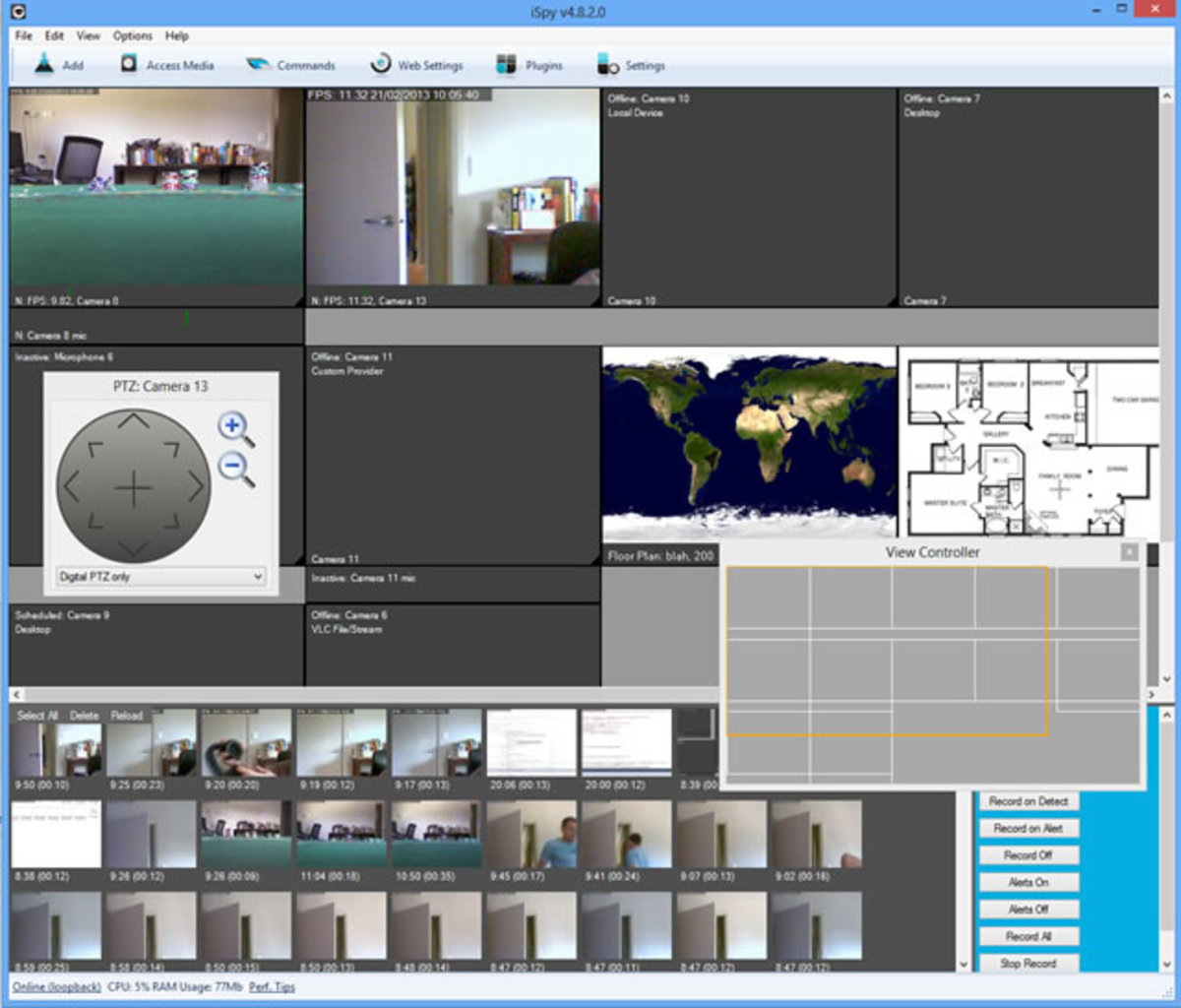More Email Clients for the Linux Desktop

When I wrote Email Clients for the Linux Desktop, I never imagined it would be as popular of an article as it came to be. There were lots of comments on the social media sites (Facebook, Google+ and Linkedin), and it became quite apparent that many people feel passionately about their favorite email client. So I collected up a list of Linux email clients I had yet to try, downloaded and tried them out. While Evolution is still my favorite email software, there are some strong contenders in this list. So without further delay, here is my review of more Linux email clients!
(Author's note: I received numerous requests to review Opera Mail. However, as of Opera 15, the mail client is no longer integrated into the browser and is now a standalone program. As of the time of writing, there is not a Linux version of that mail client.)
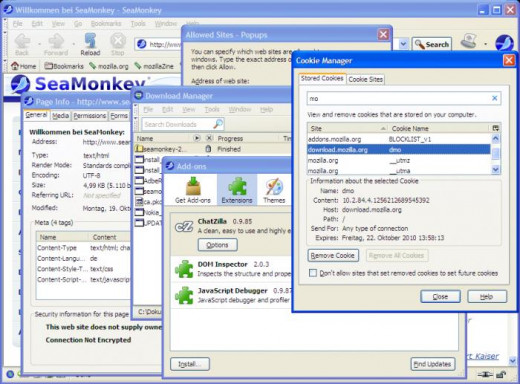
SeaMonkey Video Review
SeaMonkey
For those who were using Netscape Navigator to email and (slowly) cruise the internet in the mid to late 90's, you're going to fell a nostalgic familiarity with SeaMonkey email. This is a continuation of the Mozilla Application Suite, which was abandoned by Mozilla in 2005. At that time, the suite was renamed SeaMonkey, and product development shifted to a community development model, guided by a group called the SeaMonkey Council. You can read a full review in my article Kicking it Old School with SeaMonkey; on this page I will deal only with the email portion of the program.
The interface is very much like the old Netscape, and I found the toolbar simple and intuitive to understand. (Personally, I like the graphics of the toolbar better than the one used in Thunderbird.) I also like the min-dropdowns in the toolbar, which are such a time saver (for example, when writing an email and I click “Compose”, I can instantly select between HTML or plain text). Like Thunderbird, multiple emails can be kept open via tabbed browsing. This is an enormously useful feature, something I think all email clients should include.
Unfortunately, setting up email in SeaMonkey is not nearly as easy as Thunderbird. When you configure your email accounts, you will need to know SSL/TLS settings, port number, encryption type and server settings. Granted, most email providers give you these settings, but many email clients can configure these automatically. By the way, SeaMonkey supports IMAP and POP, as well as multiple accounts.
The address book is fairly simple and easy to use, although importing via Vcards is a bit tricky. A much easier solution is to sync with Google Contacts, which is possible with a plugin. The same is true of a calendar (which is the same calendar used in Thunderbird, by the way).
One of the greatest things about this email client is the plugins. Like Thunderbird and Firefox, there are thousands of plugins available. Quite possibly one of the most important is Enigma Mail which allows for Open PGP message encryption. Another interesting one is Awesome IdapInfoShow, which displays the contact photo for Gmail users and the like.
Overall, I enjoyed using this client. If you are someone who is typically working with email and internet at the same time, it might be worth your while.
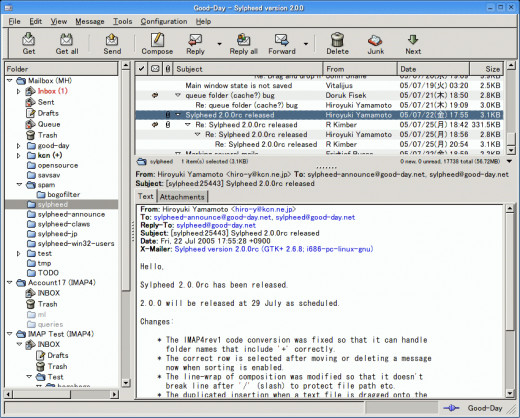
Sylpheed
Looking for a simple, bare bones email client that is lightning fast? Then Sylpheed may be just for you. This is a light and fast email client that packaged with many LXDE distributions (although it can be used with multiple platforms). Like many other lightweights, it is strictly an email client, with no other features such as calendar, instant messenger, or note taking app.
The interface graphics are definitely late 90's-ish, which may or may not be to your liking (I personally like it). The layout is a typical drop-down menu with a toolbar underneath. The toolbar can be configured easily, and it took me just a few minutes to set the layout the way I liked.
Account set-up is easy if you're a Gmail user. For everyone not on Gmail, you'll have to know all of you server settings. Multiple accounts are supported, and you can use either POP or IMAP email. You can also import old email/contacts via mbox, eml, or dbx (Outlook Express) files. GPG encryption is supported as well.
I found Sylpheed to be fast and glitch free, but there were a few features missing that I found myself wishing for. First, there is no support for HTML mail. This is a big issue for me, as much of my work depends on working in HTML. If you're a Gmail user, you can't sync contacts. When composing emails, it is a MAJOR pain to insert hyperlinks. Sylpheed does offer the option to use an external editor for composing messages, but to me this is a half-baked solution at best. One of the core functions of an email client is to write email, so why should I have to switch to another text editor to write my email?
If you like Sylpheed but would like a few more features added, then read on and check out Claws Mail... it might be what you're looking for!
Claws Mail Video Review
Claws Mail
Take Sylpheed, add a few features, and you have Claws Mail. Originally a fork of Sylpheed, Claws is a lightweight email client that covers all of the basics, but without extra baggage. It is multi-plaform, so if you bounce between Windows and Linux and want the same email program on each platform, this may be a good option.
The interface is identical to Sylpheed; in fact, nearly everything about this software is the same. So what has been added? HTML rendering for one. When you view an email, you now have the option of viewing as text or HTML. However, like in Sylpheed you can't compose HTML mail. There is also an ant-spam plugin (called Spam Assassin) which greatly reduces those annoying and unwanted bulk mailers. PDFs and RSS feeds can be read as well.
For those who wanted a calendar, one has been added via a plugin. The integration is pretty slick. The calendar shows up as a folder in you mailbox, and allows you to mark dates and times of appointments. But it goes one step further and allows for vCalendar integration. So if you receive a vCalendar invitation, it can be accepted and the appointment will be added to your calendar, as well as notify the sender of you acceptance. You can also choose to receive appointment reminders, as well as publish your full calendar online to dhow others you free and busy times.
Security may be the biggest improvement over Sylpheed. Although it is a little involved to set up, Claws Mail supports digital signature and encryption handling. There are plenty of security options as well, including the automatic checking of digital signatures, Use gpg-agent to manage passwords, how to encrypt email and more.
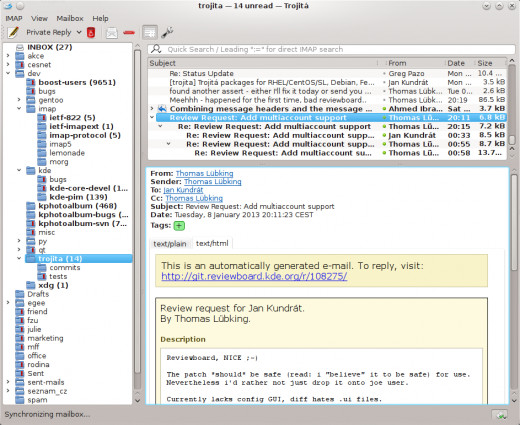
Trojitá
Are you a KDE user but don't want the entire Kontact suite? Then check out Trojitá! Designed as a light, fast IMAP email client, Trojitá does one thing and one thing only... access your IMAP email (that's right, no POP3 services). Because there are no extra applications attached, this little piece of software is extremely fast. It is also extremely light on computing resources, so if you are the kind of person who is always multi-tasking at the keyboard (that's me), running this little gem is not going to suck down precious resources.
Although Trojitá was designed using the Qt C++ library, it is not limited to KDE users only. Not only can it be used in Gnome-based desktops, it has also been ported to MAC and Windows as well. I personally tried both the Windows and Linux (Cinnamon desktop) versions, and found both to be fast, efficient and without bugs.
Setting up email accounts is pretty straight forward, although you will need to know SSL/TLS settings, port number, encryption type and server settings, just as in SeaMonkey. You have the option of adding your password while setting up the account, or you can add it each time you log in.
There are not many viewing options. You can select a traditional three panel layout, a two panel layout, or a single panel layout that opens individual emails in a new window. There are options to display the toolbar and main menu, and that's it. No fancy plugins, no changing font size, nothing else. Speaking of viewing email, one feature I really like is each email window has a pair of tabs; one to read the mail in plain text, one to read in HTML. This is an extremely simple solution to the “HTML or text” question, and is something other email clients should consider implementing.
While you have to love the simplicity of this program, there are a few things missing that would greatly enhance the package. First, there is no search function. Second, contacts can only be added to the address book one at a time, and there is no option to sync with Google or Yahoo Contacts. Finally, if you're concerned about security, there are no options for message encryption. Still, if you're look for a simple, fast email application, Trojitá may be worth looking at.
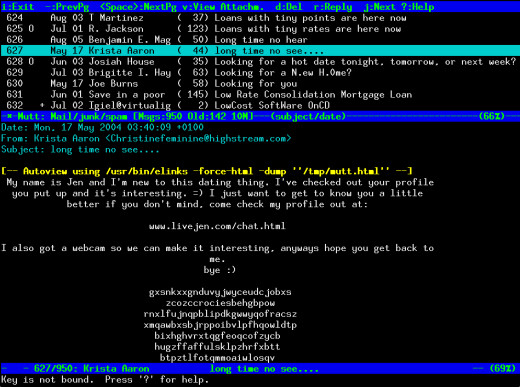
Command Line Email
Many Linux users tend to be command-line people. If this is you, then perhaps you may enjoy running you email out of the terminal. There are several that do so, and the four most common are:
-
Alpine
-
Balsa
-
Mutt
-
Pine
I played around with all four of these and found out that working email from the terminal is not for me. There is nothing inherently wrong with it, but I was never comfortable using any of these programs. Still, each one is a free open-sourced application, so there is no reason not to give one a try.
Conclusion
So what is the best email client? Really, it comes down to personal preferences and needs, as every program listed here is great in its own right. As I stated in Email Clients for the Linux Desktop, I use Evolution mail, and I found nothing here that would change me from that application. However, I think Claws Mail, Sylpheed, and Trojitá all present great opportunities if you need a lightweight email client for a low powered netbook. And if you're using both Thunderbird and Foxfire, why not combine the programs and use SeaMonkey? Of course, each of these programs are free, so if you can try them out without it costing you a cent.
I hope you've enjoyed this hub. Which email client do you prefer? Let everyone hear about it by commenting below!



